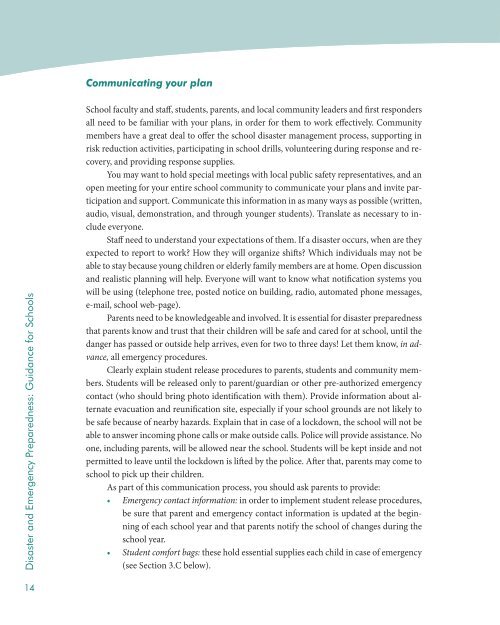Disaster and Emergency Preparedness: Guidance for ... - INEE Toolkit
Disaster and Emergency Preparedness: Guidance for ... - INEE Toolkit
Disaster and Emergency Preparedness: Guidance for ... - INEE Toolkit
Create successful ePaper yourself
Turn your PDF publications into a flip-book with our unique Google optimized e-Paper software.
Communicating your plan<strong>Disaster</strong> <strong>and</strong> <strong>Emergency</strong> <strong>Preparedness</strong>: <strong>Guidance</strong> <strong>for</strong> SchoolsSchool faculty <strong>and</strong> staff, students, parents, <strong>and</strong> local community leaders <strong>and</strong> first respondersall need to be familiar with your plans, in order <strong>for</strong> them to work effectively. Communitymembers have a great deal to offer the school disaster management process, supporting inrisk reduction activities, participating in school drills, volunteering during response <strong>and</strong> recovery,<strong>and</strong> providing response supplies.You may want to hold special meetings with local public safety representatives, <strong>and</strong> anopen meeting <strong>for</strong> your entire school community to communicate your plans <strong>and</strong> invite participation<strong>and</strong> support. Communicate this in<strong>for</strong>mation in as many ways as possible (written,audio, visual, demonstration, <strong>and</strong> through younger students). Translate as necessary to includeeveryone.Staff need to underst<strong>and</strong> your expectations of them. If a disaster occurs, when are theyexpected to report to work? How they will organize shifts? Which individuals may not beable to stay because young children or elderly family members are at home. Open discussion<strong>and</strong> realistic planning will help. Everyone will want to know what notification systems youwill be using (telephone tree, posted notice on building, radio, automated phone messages,e-mail, school web-page).Parents need to be knowledgeable <strong>and</strong> involved. It is essential <strong>for</strong> disaster preparednessthat parents know <strong>and</strong> trust that their children will be safe <strong>and</strong> cared <strong>for</strong> at school, until thedanger has passed or outside help arrives, even <strong>for</strong> two to three days! Let them know, in advance,all emergency procedures.Clearly explain student release procedures to parents, students <strong>and</strong> community members.Students will be released only to parent/guardian or other pre-authorized emergencycontact (who should bring photo identification with them). Provide in<strong>for</strong>mation about alternateevacuation <strong>and</strong> reunification site, especially if your school grounds are not likely tobe safe because of nearby hazards. Explain that in case of a lockdown, the school will not beable to answer incoming phone calls or make outside calls. Police will provide assistance. Noone, including parents, will be allowed near the school. Students will be kept inside <strong>and</strong> notpermitted to leave until the lockdown is lifted by the police. After that, parents may come toschool to pick up their children.As part of this communication process, you should ask parents to provide: <strong>Emergency</strong> contact in<strong>for</strong>mation: in order to implement student release procedures,be sure that parent <strong>and</strong> emergency contact in<strong>for</strong>mation is updated at the beginningof each school year <strong>and</strong> that parents notify the school of changes during theschool year. Student com<strong>for</strong>t bags: these hold essential supplies each child in case of emergency(see Section 3.C below).14
















